As you start planning your rock garden, you're likely flooded with ideas – from recreating a natural landscape to crafting intricate patterns with rocks and pebbles. You might be drawn to the low-maintenance charm of succulents or the serene simplicity of a Japanese-inspired design. Whatever your vision, crucially, you must strike a balance between rocks and plants, and to incorporate visually striking features that will elevate your space. But where do you start, and how do you bring your unique vision to life?
Small Rock Garden Designs
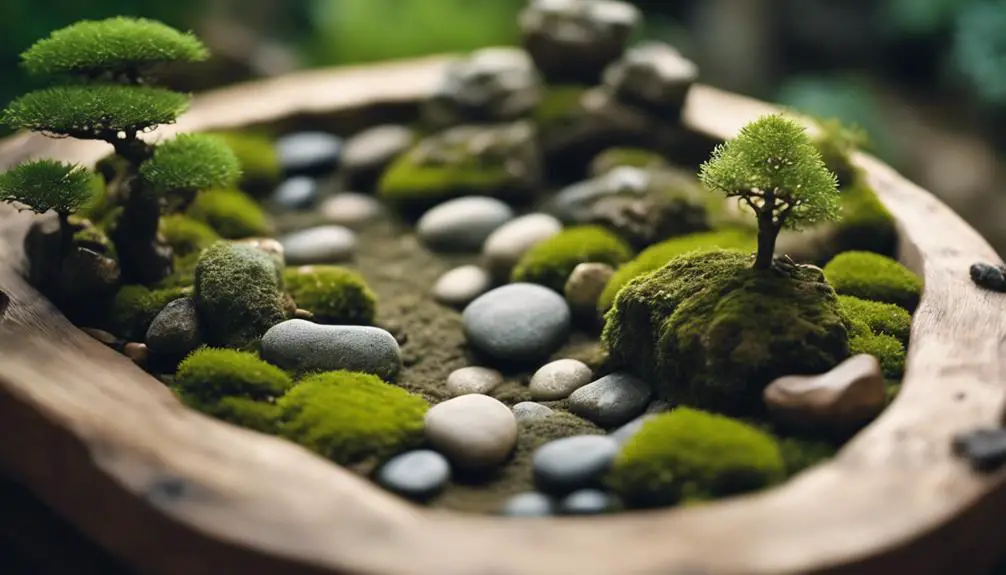
How do you envision your small rock garden design – a serene oasis in a compact space or a vibrant display of textures and colors? Whatever your vision, small rock gardens offer endless possibilities for creative expression.
You can create a mini landscape that echoes the natural world, with rocky outcrops and carefully placed stones evoking the rugged beauty of the wilderness. Alternatively, you can opt for a more abstract approach, using rocks and pebbles to create intricate patterns and designs.
To achieve a sense of balance and harmony, consider the principles of visual flow and negative space.
Place larger rocks strategically to create focal points, and use smaller stones to fill in the gaps. Don't be afraid to experiment with different textures and colors to add depth and interest. And remember, a small rock garden is all about restraint – less is often more, so edit your design carefully to confirm every element serves a purpose.
Succulent Rock Garden Ideas
What draws you to succulent rock garden ideas – the thrill of combining two low-maintenance elements or the promise of a visually striking display?
Succulent rock gardens offer endless possibilities for creative expression, especially when it comes to succulent pairings.
By combining succulents with complementary shapes, textures, and Succulent Colors, you can create a visually stunning arrangement that's both harmonious and contrasting.
For instance, pair the soft, rounded leaves of echeveria with the spiky, upright stems of aloe or agave. Alternatively, juxtapose the cool, blue-gray tones of sempervivum with the warm, golden hues of sedum.
When designing your succulent rock garden, consider the varying heights, shapes, and growth habits of your chosen succulents.
Use rocks of different sizes and textures to create a visually appealing backdrop, and don't be afraid to add decorative elements like driftwood, moss, or small ornaments to enhance the overall aesthetic.
Japanese-Inspired Rock Gardens
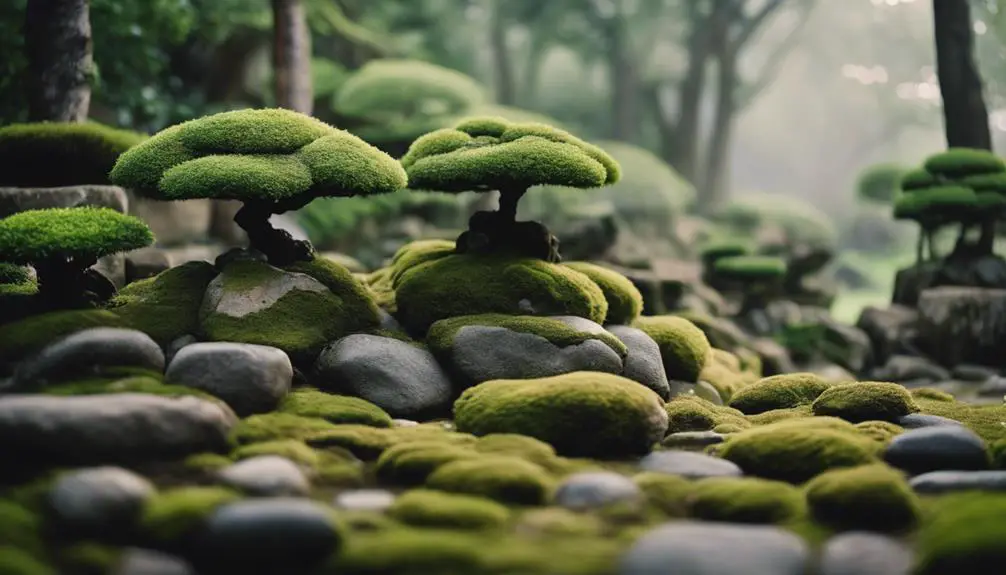
Frequently, Japanese-inspired rock gardens evoke a sense of serenity and calm, transporting you to a tranquil oasis.
To create this ambiance, you'll want to focus on simplicity, restraint, and subtlety. Start by choosing rocks of varying sizes and textures, arranging them in a deliberate, yet natural-looking pattern.
Raked gravel, often in a circular motion, adds visual interest and creates a sense of movement. Incorporate plants with clean lines, like bamboo or moss, to reinforce the Zen aesthetics.
Consider adding a focal point, such as a weathered stone lantern or a carefully pruned tree, to draw the eye and create visual balance.
As you design your garden, remember to balance the yin and yang elements – soft, curved lines versus hard, angular ones.
Rock Garden Edging Ideas
As you define the boundaries of your rock garden, selecting the right edging material becomes crucial to achieving a cohesive look.
The edging you choose won't only contain the rocks and plants but also create a visual flow that ties the entire space together. For a modern take on traditional Rock Border Ideas, consider using metal edging with a rusted or weathered finish.
This will add an industrial touch to your rock garden while creating a clean, defined edge.
Alternatively, you can opt for Stone Edge Designs that incorporate natural materials like bluestone, fieldstone, or flagstone.
These materials will blend seamlessly with the rocks and gravel, creating a harmonious shift between the different elements of your garden.
When selecting stone edging, consider the color and texture of the rocks and plants in your garden to confirm a cohesive look.
You can also experiment with different patterns, such as a staggered or serpentine design, to add visual interest to your rock garden.
DIY Rock Garden Paths
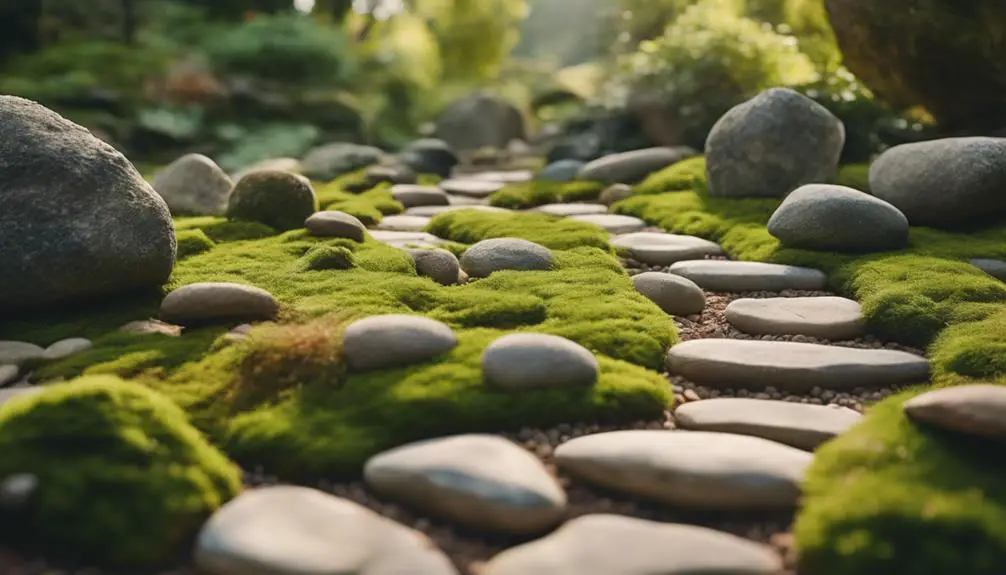
With the edging in place, you're now ready to create pathways that guide visitors through your rock garden.
To start, decide on the type of rocky flooring you want to use. You can opt for large, flat stones, gravel, or even a mix of materials for a unique look. Consider the overall aesthetic you want to achieve and the level of maintenance you're willing to commit to.
For example, gravel paths require regular raking to maintain their appearance, while stone paths are more low-maintenance.
Once you've chosen your material, begin laying out the path. Use a hose or rope to mark the desired path, taking into account any obstacles or features you want to highlight.
Then, start placing your chosen material, working from the center outwards to guarantee even coverage. To add visual interest, consider incorporating pebble inlays or other decorative elements.
These can be used to create patterns, borders, or even entire sections of the path. With a little creativity, your DIY rock garden paths can become a stunning focal point in your outdoor space.
Rock Garden Water Features
Adding a water feature to your rock garden can elevate the space, creating a sensory experience that engages visitors on multiple levels.
By incorporating a Rock Fountain, you can create a visually striking focal point that draws the eye and soothes the soul. Consider installing a small pump to circulate water through a series of rocks, creating a gentle trickle that adds auditory appeal to your garden.
For a more dramatic effect, consider incorporating a Water Cascade into your design.
This can be achieved by creating a series of rock shelves, allowing water to flow from one level to the next, creating a mesmerizing display of sound and movement. To add an extra layer of visual interest, incorporate different textures and colors of rock, allowing the water to flow over and around them.
When designing your water feature, be mindful of the surrounding environment and consider the scale and proportion of the feature in relation to the rest of the garden.
Desert Rock Garden Landscaping

As you design your desert rock garden, you'll want to ponder a landscape that showcases drought-tolerant plants, such as succulents and cacti, thriving in rocky terrain.
Your plant selection should prioritize species that can withstand intense sunlight and infrequent watering, while also adding visual interest with unique textures and shapes.
Desert Rock Garden Design
Desert rock gardens burst forth with vibrant colors and textures, a striking contrast to the arid landscape that surrounds them.
You'll create a visually stunning design by incorporating desert blooms in bold, sweeping strokes across the landscape. Choose a palette of drought-tolerant plants with varying shapes, sizes, and colors to add depth and interest.
Consider planting succulents like aloe, agave, or echeveria alongside cacti and yucca to create a dramatic, sculptural effect.
To add texture and visual interest, incorporate rocky outcrops into your design.
You can use large boulders or smaller stones to create a natural, organic look.
Consider creating a focal point, like a large rock formation or a statement piece of driftwood, to draw the eye through the garden.
Use gravel or decomposed granite as a groundcover to unify the space and provide good drainage.
With careful planning and attention to detail, your desert rock garden will be a vibrant oasis in the desert landscape.
Rocky Terrain Plant Selection
With your desert rock garden's design framework established, you're ready to select plants that thrive in rocky terrain.
When choosing plants, consider their adaptability to shallow soil, intense sunlight, and limited water availability. Succulents and drought-tolerant species are ideal for desert rock gardens, as they've evolved to survive in harsh conditions.
Opt for plants with deep taproots, like ocotillo or Texas sage, which can anchor themselves in rocky outcroppings.
Soil preparation is vital, as it directly impacts plant growth.
Since desert rock gardens often feature shallow soil, amend it with organic matter like compost or well-rotted manure to improve its water-holding capacity. This will help plants establish a strong root system, allowing them to thrive in the challenging desert environment.
Additionally, consider using a drip irrigation system to deliver water directly to the roots, reducing evaporation and runoff.
Southwest Inspired Hardscapes
Your desert rock garden's layout is taking shape, and now it's time to focus on the hardscapes that will bring your Southwest-inspired vision to life.
To create a cohesive look, choose materials that reflect the natural beauty of the desert landscape. Consider using decomposed granite or crushed stone pathways that blend seamlessly with the surrounding terrain.
Incorporate Southwest accents, such as terracotta or rust-colored pavers, to add warmth and depth to your design.
Desert textures, like weathered wood or rusty metal, can also be used to create visually appealing contrasts.
For a striking focal point, install a statement piece, like a rusted metal sculpture or a natural stone bench, that resonates with the desert's rugged charm.
When selecting hardscape materials, remember to prioritize durability and low maintenance.
Desert climates can be unforgiving, so opt for materials that can withstand extreme temperatures and weather conditions.
Rock Garden Plant Combinations
You'll want to balance contrasting textures, forms, and colors to create visually appealing rock harmony concepts in your garden.
When selecting drought-tolerant plants, consider combining succulents with varying leaf shapes and sizes, such as aloe, echeveria, and sedum.
Rock Harmony Concepts
Several key principles underpin successful rock harmony concepts, which involve combining plants with rocks to create visually stunning rock gardens.
You'll want to achieve Rock Balance by considering the size, shape, and color of both the rocks and plants. This balance is vital in creating a sense of harmony and visual flow.
Stone Unity is another critical concept, where you select rocks and plants that share similar textures, colors, or forms to create a cohesive look.
To achieve this, you can group plants with similar foliage or flowers together, and then complement them with rocks that share similar hues or textures.
Consider the mature size of your plants and leave enough space between them for proper growth. You can also create visual interest by contrasting plants with different growth habits, such as pairing upright plants with spreading ones.
Finally, don't forget to add some negative space to your design, as this will create a sense of calm and allow the eye to rest.
Drought Tolerant Choices
By incorporating drought-tolerant plants into your rock garden design, you can create a stunning and low-maintenance oasis that thrives even in water-scarce conditions.
Desert blooms like succulents, yucca, and agave are perfect for Xeriscape designs, which prioritize water efficiency and minimal maintenance. These plants have adapted to survive in arid environments, making them ideal for rock gardens in dry climates.
When selecting drought-tolerant plants, consider their growth habits, textures, and colors to create visual interest.
For example, pair spiky succulents with smooth-leaved shrubs or contrast bright blooms with muted foliage. You can also incorporate groundcovers like creeping thyme or sedum to fill gaps between rocks and create a lush, verdant appearance.
To take your drought-tolerant rock garden to the next level, incorporate hardscaping elements like gravel, decomposed granite, or flagstone to create a cohesive, desert-inspired aesthetic.
Creating a Rock Garden Border
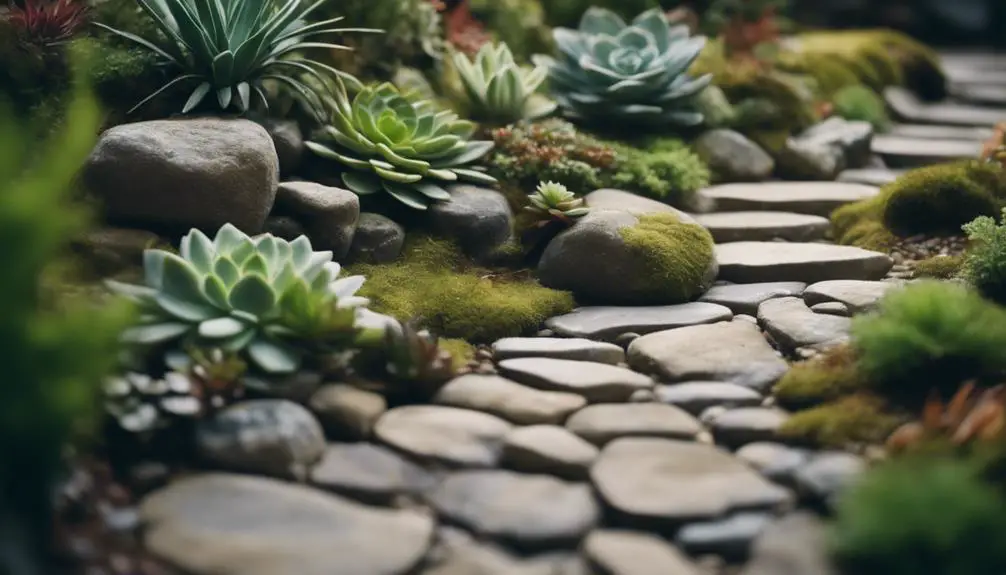
As you envision your rock garden, the border serves as a crucial element, framing the space and guiding the viewer's eye through the arrangement.
A well-designed rock boundary creates a sense of containment, defining the garden's edges and preventing the rocks from spilling out into the surrounding landscape.
To create a visually appealing border, ponder using a mix of rocks in varying sizes and textures to add depth and interest.
Stone framing is another technique to ponder, where larger stones are placed at regular intervals to create a sense of rhythm and harmony.
This can be particularly effective when combined with smaller rocks and gravel, which can be used to fill in the gaps and create a sense of movement.
When selecting rocks for your border, ponder their color, texture, and shape, and how they'll complement the rest of your garden design.
Rock Garden Lighting Ideas
Lighting can dramatically alter the ambiance of your rock garden, transforming it from a daytime oasis to a nighttime haven.
As you plan your rock garden lighting, consider the type of illumination you want to achieve. Solar lights are an excellent option, as they're energy-efficient and environmentally friendly. You can place them along pathways, around plantings, or at the base of large rocks to create a soft, warm glow.
To create a more dramatic effect, try Moonlighting, a technique that involves placing lights at the base of trees or large rocks to cast a soft, downward glow.
This creates the illusion of moonlight filtering through the garden, adding depth and visual interest. Consider using spotlights to highlight specific features, like a large boulder or a colorful plant.
You can also use string lights or fairy lights to add a whimsical touch. Whatever lighting scheme you choose, remember to balance brightness with ambiance – you want to create a peaceful, inviting atmosphere that draws you in, not overwhelms.
Rock Garden Maintenance Tips
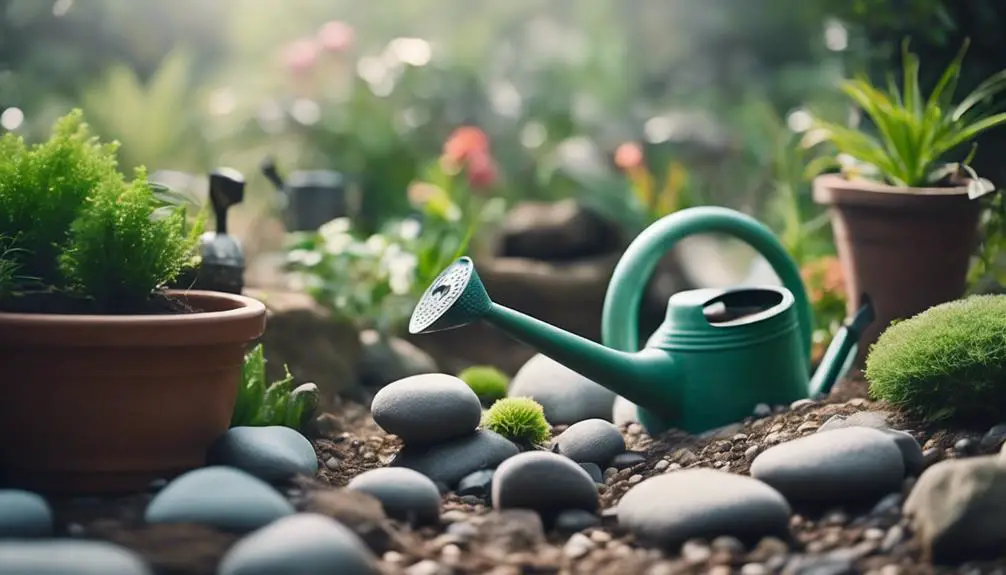
Now that your rock garden is illuminated, it's time to focus on keeping it looking its best.
Regular maintenance is vital to prevent your garden from looking cluttered and overgrown. You'll need to remove rock debris, such as small stones and pebbles, that can accumulate on the surface.
Use a rake or a blower to clear the area, making sure to get into all the nooks and crannies.
Next, implement weed prevention strategies to stop unwanted growth from taking over. Mulch can be an effective barrier, but you'll need to replenish it periodically.
Alternatively, consider using a landscape fabric, which can be installed beneath the rocks to prevent weeds from growing. For added protection, apply a pre-emergent herbicide to prevent weeds from germinating.
Incorporating Statues and Ornaments
You'll want to thoughtfully position figurines among the stones to create visually appealing vignettes, drawing the eye to specific areas of your rock garden.
Whimsical garden accents, like tiny benches or fairy-sized furniture, can add a touch of fantasy and personality to your outdoor space. By carefully selecting and placing these ornaments, you can create a unique, immersive experience that invites exploration and discovery.
Figurines Among the Stones
Harmony is achieved when figurines are carefully placed among the stones, transforming your rock garden into a unique visual experience.
By thoughtfully selecting and arranging figurines, you create a narrative that weaves together the natural beauty of the rocks and plants with the whimsy of mythic creatures and fantasy landscapes.
Consider placing a delicate fairy perched on a moss-covered stone, or a majestic dragon coiled around a boulder.
The key is to balance the figurines with the natural elements, ensuring they complement rather than overwhelm the space.
Play with scale, texture, and color to create visual interest and depth.
For example, a small, intricately detailed mermaid can be nestled among smooth river rocks, while a larger, bold statue of a griffin can anchor a corner of the garden.
Whimsical Garden Accents
As dawn breaks over your rock garden, whimsical garden accents come alive, infusing the space with personality and charm.
You can incorporate statues and ornaments that reflect your unique style, creating a visually appealing and immersive experience. Consider adding fairy decor, such as tiny furniture or accessories, to create a sense of wonder and magic.
Mini sculptures, like small animals or mythical creatures, can also add a touch of whimsy to your garden.
To create a cohesive look, choose accents that complement your garden's color palette and theme.
For example, if your garden has a natural, earthy tone, opt for accents made from natural materials like stone or wood. You can also group accents together to create a focal point or scatter them throughout the garden to create a sense of discovery.
When placing your accents, consider the scale and proportion of each piece to guarantee they don't overwhelm the surrounding plants and stones.
Frequently Asked Questions
Can I Use Rocks of Different Colors in the Same Garden?
You can create striking visual interest by combining rocks of different colors, leveraging color contrast to add depth and dimension. To achieve rock harmony, balance bold hues with neutral tones, and consider the natural surroundings to certify a cohesive look.
How Deep Should the Base Layer of Rocks Be?
When designing a layered rock system, you'll want to guarantee the base layer is deep enough to facilitate proper drainage, typically 2-3 inches, considering rock size and spacing to prevent waterlogging and promote aeration.
Can I Create a Rock Garden on a Slope?
When tackling a slope, you'll need to prioritize stabilization and drainage management. Start by evaluating the incline's pitch, then design a tiered system with retaining walls, and incorporate permeable materials to mitigate erosion and guarantee a secure, visually striking landscape.
Will Weeds Grow up Through the Rocks and Gravel?
As you design your landscape, you'll wonder if weeds will push through the rocks and gravel – but with a robust weed barrier and strategic mulch layers, you'll effectively suppress unwanted growth, ensuring a visually stunning and low-maintenance space.
Can I Use a Rock Garden as a Fire Pit Area?
You can create a stunning fire pit area by incorporating a fire ring design that complements your outdoor space, and thoughtfully arranging pit seating to guarantee a cozy gathering spot, all while maintaining a safe distance from flammable materials.
Conclusion
As you finalize your rock garden design, remember to balance visual elements, incorporating a mix of textures, colors, and shapes. Combine plants with complementary features, like water elements and pathways, to create a cohesive look. Don't forget to contemplate edging, lighting, and maintenance when bringing your vision to life. By doing so, you'll create a stunning outdoor space that showcases the beauty of rocks and plants in harmony.




